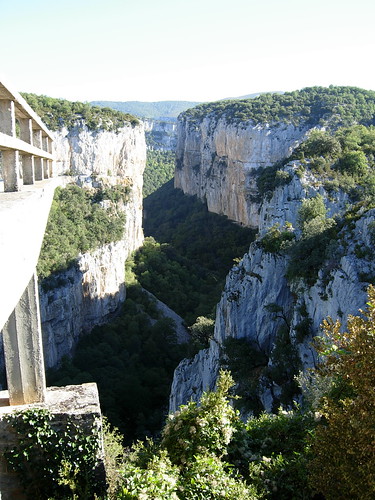
It’s called the gorges gorges cut by rivers when run through the limestone rocks. The vertical walls have been carved by erosion, while the river is fit, over millions of years, resulting in these spectacular formations own pre-Pyrenean basin. Within the gorges the elements combine to create special environments: vertical walls, shelves, slopes, stony, riverside.
The shelter from the winds in winter, shade in summer and the humidity of the river are some factors that influence the emergence of a diverse and distinctive vegetation of considerable interest, Kermes with arbutus, maple, mountain ash, beech, oaks, cherry, lime, walnut, elm, ash and willows. The set features color seasonal variability of remarkable beauty.

The shelves and walls are inaccessible, protecting the persistence of endemic flora, refugees in the gorges for millions of years. The wildlife is rich. Is large raptors and nesting species living in the crags: vultures, vulture, Egyptian vulture, golden eagle, peregrine falcon, owl, Stock Dove, Jackdaw and swift.
All the gorges have been declared as nature reserves and protected natural areas that are of great richness and fragility. Highlights, including the gorges of Lumbier and Arbayún public access and enjoyment which is regulated as well as Ugarrón Benas and also regulated. It is advisable to visit the Interpretation Center of the de Lumbier where there is interactive information and interpretation about these beautiful places.
Palaces and Castles
Symbols of nobility and power in pre Pyrenean basins are excellent examples of castles, palaces and towers. In rural areas is not entirely clear the distinction between palaces and castles. The castles and Headlands armory buildings defensive purposes, become palaces when they have some kind of luxury or luxury for the enjoyment of the lord or the king.
There were many places in the valleys of the Pyrenees and pre-Pyrenees of Navarre, but was in the past where most were lavished.
– The fortified palace Liberri (Lónguida) close to Aos. Built in the fourteenth or fifteenth century and reformed in the sixteenth century, this former manor retains the old tower of ashlar.
– The palace and tower Ayanz (Lónguida), similar to the previous structure. Both fine examples of late Gothic palaces of Navarre.
– The Baroque Palace Antillón or those of Jaureguizar XVIII, originally from the fifteenth and remodeled in the eighteenth, both in Lumbier, are the highlights of the region.
– Palace Artieda (Urraul Bass) is a model gothic castle-palace, with strong towers and aspillerazas central courtyard. Beaumont stronghold was featured in the civil wars that raged in the fifteenth century the kingdom of Navarre.
– Palace Rípodas (Urraul Bass), medieval, ancient palace tower was Cape Armory.
– Irurozki Palaces and Arielz (Urraul Alto), fine examples of Headlands Armory with robust towers, are cited in the book Guns sXVIII.
– Palacio de Arrieta (Arce), retains its medieval tower of a defensive nature. Cape quoted as a ratio of Armory sXVIII.
Izaga
Izaga the rock is among the valleys and Izagaondoa Unciti that bears its name. It is actually a vast structure, whose summit is homonymous to 1360 m. From the top, next to the chapel of San Miguel (sxii), wide panorama of valleys and peaks of the Pyrenees, and his feet a range of possibilities: walking, mountain biking, cultural and natural heritage. It can be reached on foot from several places: Ardanaz, Zuazua, through beautiful paths in which we enjoy as we ascend the wide range and variation of plant strata.
/foto1.jpg)
Come back tomorrow…
Leave a Reply
You must be logged in to post a comment.
Recent Comments